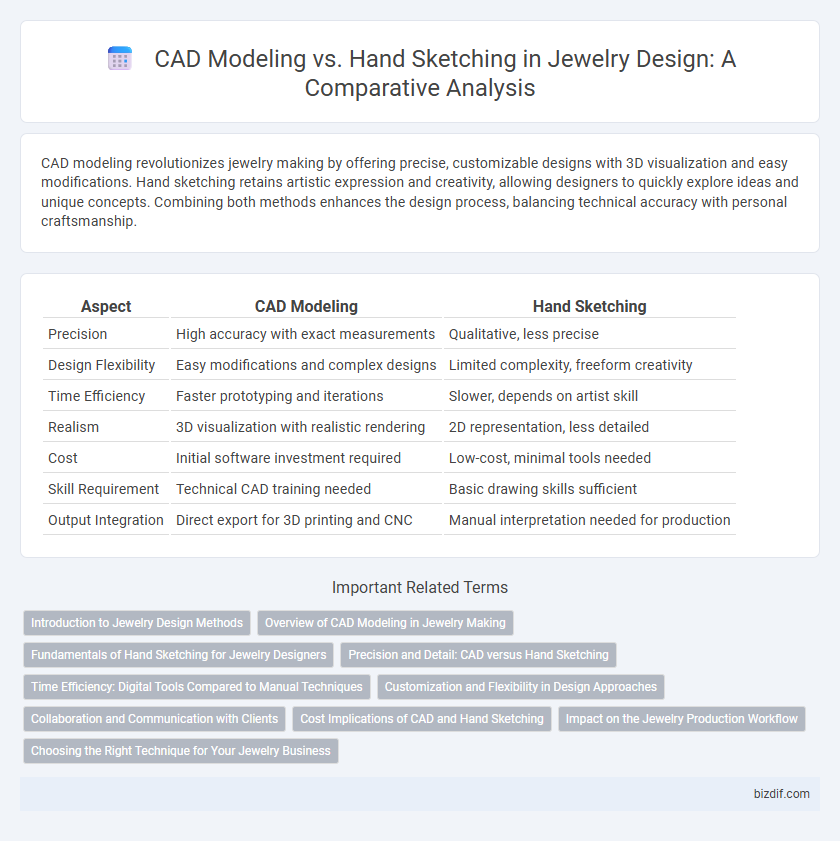CAD modeling revolutionizes jewelry making by offering precise, customizable designs with 3D visualization and easy modifications. Hand sketching retains artistic expression and creativity, allowing designers to quickly explore ideas and unique concepts. Combining both methods enhances the design process, balancing technical accuracy with personal craftsmanship.
Table of Comparison
| Aspect | CAD Modeling | Hand Sketching |
|---|---|---|
| Precision | High accuracy with exact measurements | Qualitative, less precise |
| Design Flexibility | Easy modifications and complex designs | Limited complexity, freeform creativity |
| Time Efficiency | Faster prototyping and iterations | Slower, depends on artist skill |
| Realism | 3D visualization with realistic rendering | 2D representation, less detailed |
| Cost | Initial software investment required | Low-cost, minimal tools needed |
| Skill Requirement | Technical CAD training needed | Basic drawing skills sufficient |
| Output Integration | Direct export for 3D printing and CNC | Manual interpretation needed for production |
Introduction to Jewelry Design Methods
CAD modeling in jewelry design offers precise, scalable, and easily modifiable 3D representations that enhance accuracy and reduce production time. Hand sketching provides an artistic and tactile approach, allowing designers to quickly explore creative concepts and personal styles with fluidity. Both methods form the foundation of jewelry design, balancing technical precision and creative expression.
Overview of CAD Modeling in Jewelry Making
CAD modeling in jewelry making enables precise and intricate 3D designs that enhance creativity and accuracy far beyond traditional hand sketching. This digital technique allows jewelers to visualize complex structures, make modifications easily, and produce detailed renderings for client approval or casting processes. Advanced CAD software, such as Rhino or MatrixGold, streamlines the design-to-manufacture workflow, improving efficiency and reducing material waste.
Fundamentals of Hand Sketching for Jewelry Designers
Mastering hand sketching fundamentals enables jewelry designers to quickly visualize ideas, capturing intricate details and unique shapes that serve as the foundation for CAD modeling. Sketching develops spatial awareness and artistic confidence, crucial for translating creative concepts into precise digital designs. Strong hand-drawing skills enhance communication with clients and artisans, ensuring that the final piece aligns perfectly with the initial vision.
Precision and Detail: CAD versus Hand Sketching
CAD modeling in jewelry making offers unparalleled precision and fine detail control through digital tools and software, enabling exact measurements and complex designs. Hand sketching allows for creative freedom and personalized artistic expression but may lack the accuracy and repeatability required for intricate or symmetrical pieces. Consequently, CAD is preferred for producing precise prototypes and consistent manufacturing standards, while hand sketching serves as an initial conceptual phase or for unique, bespoke designs.
Time Efficiency: Digital Tools Compared to Manual Techniques
CAD modeling in jewelry making significantly reduces design time by allowing rapid adjustments and precise detailing, enabling designers to iterate quickly without starting from scratch. Hand sketching, while offering creative freedom, often consumes more time due to manual revisions and limited accuracy in complex designs. Digital tools streamline the workflow, enhancing time efficiency and accelerating the path from concept to production.
Customization and Flexibility in Design Approaches
CAD modeling in jewelry making offers unparalleled customization and precision, enabling designers to create intricate, complex designs with exact measurements and easy modifications. Hand sketching provides greater artistic freedom and spontaneity, allowing for unique, fluid designs that can capture the artisan's personal style and immediate creative vision. Combining both methods enhances flexibility, as CAD refines and perfects initial hand-drawn concepts into detailed, manufacturable jewelry pieces.
Collaboration and Communication with Clients
CAD modeling enhances collaboration by allowing designers and clients to visualize jewelry in precise 3D detail, enabling real-time adjustments and clearer communication. Hand sketching offers a personal touch, fostering intimate client-designer interaction but may lack the accuracy and immediate feedback available through CAD. Integrating CAD modeling with hand sketches bridges artistic creativity and technical precision, optimizing client satisfaction and streamlining the design approval process.
Cost Implications of CAD and Hand Sketching
CAD modeling in jewelry making reduces long-term costs by minimizing material waste and enabling precise design adjustments before production, whereas hand sketching incurs lower initial expenses but often leads to higher revision costs and material use during prototyping. Investment in CAD software and training can be offset by faster turnaround times and improved accuracy, making it cost-effective for complex or high-volume projects. Conversely, hand sketching remains cost-efficient for simple, custom, or one-off designs but may result in increased labor and error correction costs.
Impact on the Jewelry Production Workflow
CAD modeling accelerates the jewelry production workflow by enabling precise, scalable designs that seamlessly integrate with 3D printing and CNC machining technologies. Hand sketching fosters creative exploration and unique artistic expression but often requires additional translation into digital formats, potentially extending lead times. Combining both methods balances innovation and efficiency, optimizing prototype development and customization in jewelry manufacturing.
Choosing the Right Technique for Your Jewelry Business
For jewelry businesses, selecting between CAD modeling and hand sketching hinges on desired precision, flexibility, and production scale. CAD modeling offers detailed, scalable designs with ease of modification, streamlining the prototyping and manufacturing processes. Hand sketching fosters creativity and unique personal touches, ideal for bespoke or artisanal pieces requiring an organic design approach.
CAD modeling vs Hand sketching Infographic

 bizdif.com
bizdif.com